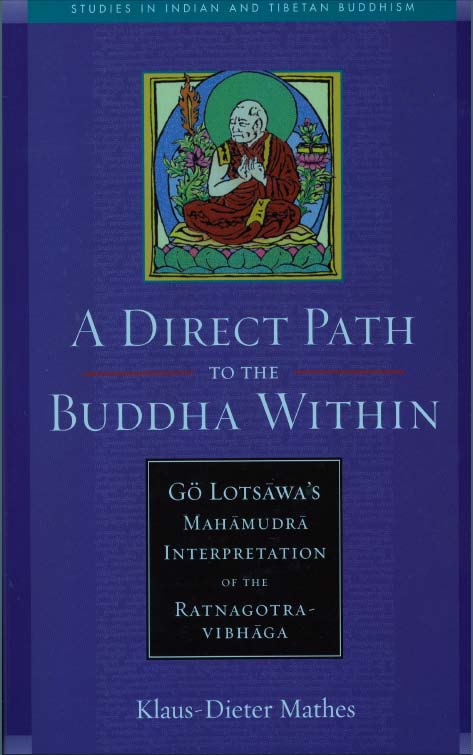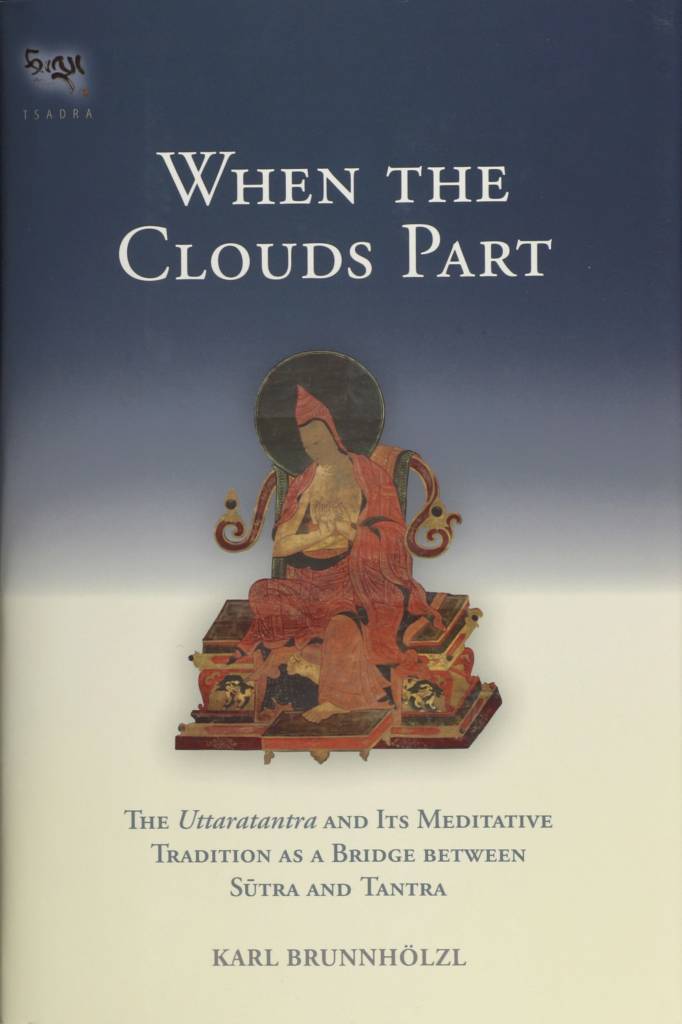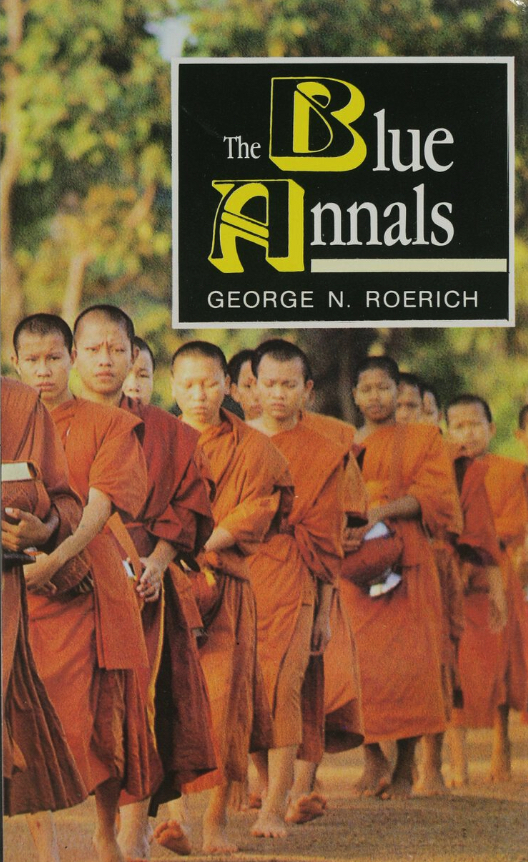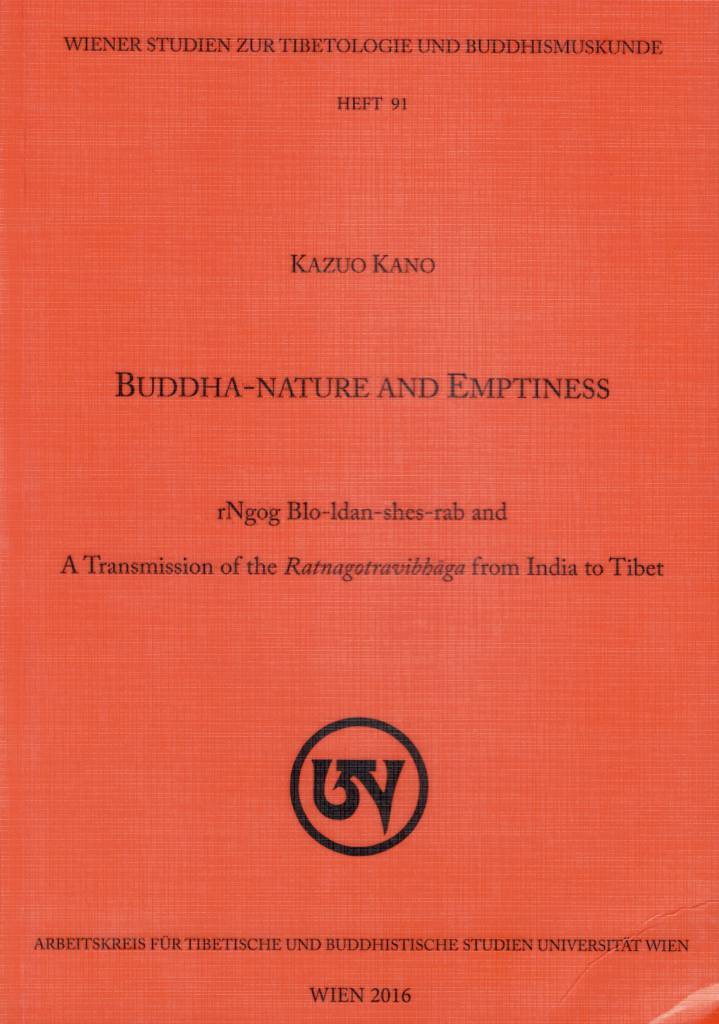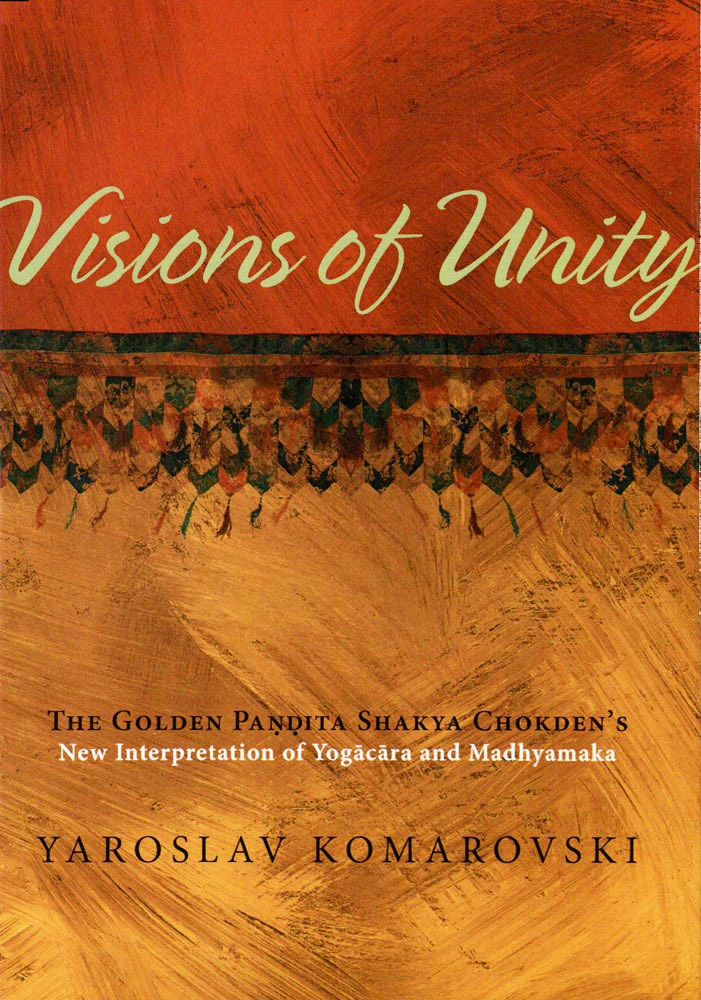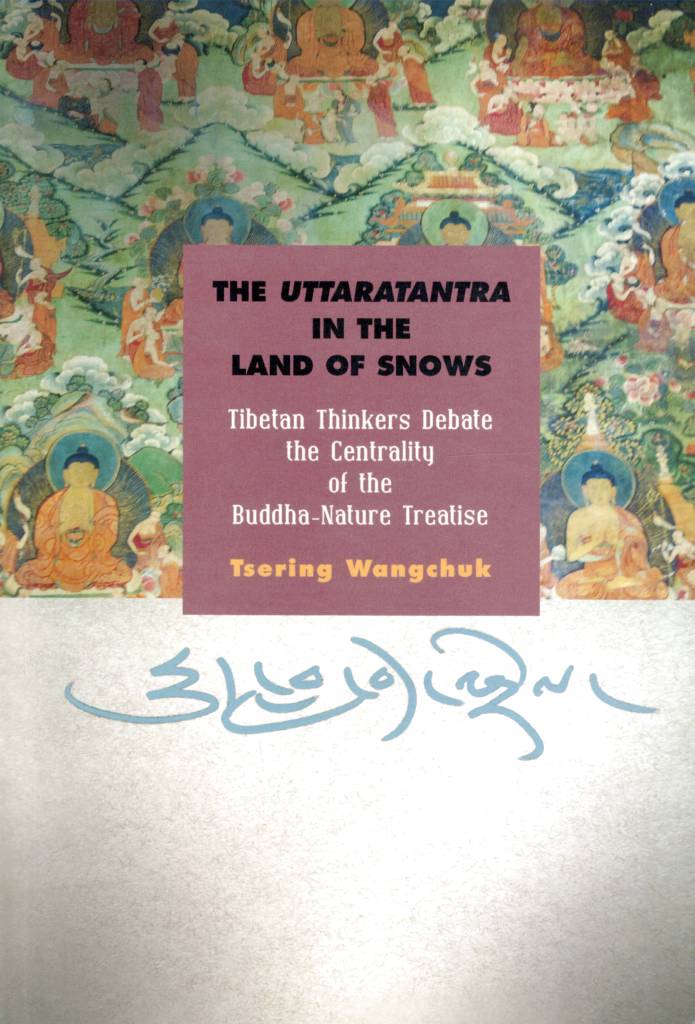The Seven Vajra Topics: Difference between revisions
No edit summary |
No edit summary |
||
| Line 43: | Line 43: | ||
{{CommentatorSeparator|Maitreya}} | {{CommentatorSeparator|Maitreya}} | ||
The first verse of the ''Ratnagotravibhāga Mahāyānottaratantraśāstra'' states: | |||
{{Blockquote|</em>बुद्धश्च धर्मश्च गणश्च धातु-<br>र्बोधिर्गुणाः कर्म च बौद्धमन्त्यम्<br>कृत्स्नस्य शास्त्रस्य शरीरमेतत्<br>समासतो वज्रपदानि सप्त<em><br><br>buddhaśca dharmaśca gaṇaśca dhātu-<br>bodhirguṇāḥ karma ca bauddhamantyam<br>kṛtsnasya śāstrasya śarīrametat<br>samāsato vajrapadāni sapta<br><br></em>།སངས་རྒྱས་ཆོས་ཚོགས་ཁམས་དང་བྱང་ཆུབ་དང་།<br>།ཡོན་ཏན་སངས་རྒྱས་ཕྲིན་ལས་ཐ་མ་སྟེ།<br>།བསྟན་བཅོས་ཀུན་གྱི་ལུས་ནི་མདོར་བསྡུ་ན།<br>།རྡོ་རྗེ་ཡི་ནི་གནས་བདུན་འདི་དག་གོ།<em><br><br>Buddha, dharma, assembly, basic element,<br>Awakening, qualities, and finally buddha activity–<br>The body of the entire treatise<br>Is summarized in these seven vajra points.|Translation from [[Brunnhölzl, Karl]]. ''[[When the Clouds Part]]: The Uttaratantra and its Meditative Tradition as a Bridge between Sūtra and Tantra''. Boston: Snow Lion Publications, an imprint of Shambhala Publications, 2014, p. 331. | {{Blockquote|</em>बुद्धश्च धर्मश्च गणश्च धातु-<br>र्बोधिर्गुणाः कर्म च बौद्धमन्त्यम्<br>कृत्स्नस्य शास्त्रस्य शरीरमेतत्<br>समासतो वज्रपदानि सप्त<em><br><br>buddhaśca dharmaśca gaṇaśca dhātu-<br>bodhirguṇāḥ karma ca bauddhamantyam<br>kṛtsnasya śāstrasya śarīrametat<br>samāsato vajrapadāni sapta<br><br></em>།སངས་རྒྱས་ཆོས་ཚོགས་ཁམས་དང་བྱང་ཆུབ་དང་།<br>།ཡོན་ཏན་སངས་རྒྱས་ཕྲིན་ལས་ཐ་མ་སྟེ།<br>།བསྟན་བཅོས་ཀུན་གྱི་ལུས་ནི་མདོར་བསྡུ་ན།<br>།རྡོ་རྗེ་ཡི་ནི་གནས་བདུན་འདི་དག་གོ།<em><br><br>Buddha, dharma, assembly, basic element,<br>Awakening, qualities, and finally buddha activity–<br>The body of the entire treatise<br>Is summarized in these seven vajra points.|Translation from [[Brunnhölzl, Karl]]. ''[[When the Clouds Part]]: The Uttaratantra and its Meditative Tradition as a Bridge between Sūtra and Tantra''. Boston: Snow Lion Publications, an imprint of Shambhala Publications, 2014, p. 331. | ||
|style=max-width: none; | |style=max-width: none; | ||
| Line 50: | Line 50: | ||
{{CommentatorSeparator|Asaṅga}} | {{CommentatorSeparator|Asaṅga}} | ||
In the commentary to verse I. | In the commentary to verse I.1, it states: | ||
{{Blockquote | {{Blockquote | ||
|</em> | |</em>།སངས་རྒྱས་ཆོས་ཚོགས་ཁམས་དང་བྱང་ཆུབ་དང་། །ཡོན་ཏན་སངས་རྒྱས་ཕྲིན་ལས་ཐ་མ་སྟེ། །བསྟན་བཅོས་ཀུན་གྱི་ལུས་ནི་མདོར་བསྡུ་ན། །རྡོ་རྗེ་ཡི་ནི་གནས་བདུན་འདི་དག་གོ། །རྟོགས་པའི་དོན་རྡོ་རྗེ་ལྟ་བུའི་གནས་ཏེ། གཞི་ཡིན་པའི་ཕྱིར་རྡོ་རྗེའི་གནས་སོ། །དེ་ལ་ཐོས་པ་དང་བསམས་པ་ལས་བྱུང་བའི་ཤེས་པས་ཕིགས་པར་དཀའ་བའི་ཕྱིར་ན་བརྗོད་དུ་མེད་པའི་རང་བཞིན་སོ་སོ་རང་གིས་རིག་པར་བྱ་བའི་དོན་རྡོ་རྗེ་ལྟ་བུར་རིག་པར་བྱའོ། །དེ་ཐོབ་པ་དང་རྗེས་སུ་མཐུན་པའི་ལམ་སྟོན་པར་བྱེད་པས་ན་དོན་དེ་བརྗོད་པའི་ཡི་གེ་གང་ཡིན་པ་དེ་དག་ནི་གནས་ཞེས་བརྗོད་དོ། །དེའི་རྟེན་དུ་གྱུར་པའི་ཕྱིར་རོ། །དེ་ལྟར་ཕིགས་པར་དཀའ་བའི་དོན་དང་། རྟེན་གྱི་དོན་གྱིས་དོན་དང་ཡི་གེ་དག་རྡོ་རྗེ་དང་གནས་ཉིད་དུ་རྟོགས་པར་བྱའོ། །དེ་ལ་དོན་ནི་གང་། ཡི་གེ་ནི་གང་ཞེ་ན། རྟོགས་པའི་དོན་རྣམ་པ་བདུན་ནི་དོན་ཞེས་བརྗོད་དེ། འདི་ལྟ་སྟེ། སངས་རྒྱས་ཀྱི་དོན་དང་། ཆོས་ཀྱི་དོན་དང་། དགེ་འདུན་གྱི་དོན་དང་། ཁམས་ཀྱི་དོན་དང་། བྱང་ཆུབ་ཀྱི་དོན་དང་། ཡོན་ཏན་གྱི་དོན་དང་། ཕྲིན་ལས་ཀྱི་དོན་དང་། འདི་ནི་དོན་ཞེས་བྱའོ། །ཡི་གེ་གང་དག་གིས་རྟོགས་པའི་དོན་རྣམ་པ་བདུན་པོ་འདི་དག་སྟོན་པར་བྱེད། གསལ་བར་བྱེད་པ་དེ་ནི་ཡི་གེ་ཞེས་བྱའོ། །རྡོ་རྗེའི་གནས་བསྟན་པ་དེ་ཡང་རྒྱས་པར་ནི་མདོ་ཇི་ལྟ་བ་བཞིན་དུ་རྟོགས་པར་བྱ་སྟེ། ཀུན་དགའ་བོ་དེ་བཞིན་གཤེགས་པ་ནི་བསྟན་དུ་མེད་པ་སྟེ། དེ་ནི་མིག་གིས་བལྟ་བར་མི་ནུས་སོ། །ཀུན་དགའ་བོ་ཆོས་ནི་བརྗོད་དུ་མེད་པ་སྟེ། དེ་ནི་རྣ་བས་མཉན་པར་མི་ནུས་སོ། །ཀུན་དགའ་བོ་དགེ་འདུན་ནི་འདུས་མ་བྱས་པ་སྟེ། དེ་ནི་ལུས་དང་སེམས་ཀྱིས་བསྙེན་བཀུར་བྱ་བར་མི་ནུས་སོ་ཞེས་རྡོ་རྗེའི་གནས་གསུམ་པོ་འདི་ནི་ལྷག་པའི་བསམ་པ་བསྟན་པའི་ལེའུའི་རྗེས་སུ་འབྲངས་ཏེ་རིག་པར་བྱའོ། །ཤཱ་རིའི་བུ་དོན་འདི་ནི་དེ་བཞིན་གཤེགས་པའི་ཡུལ་ཏེ་དེ་བཞིན་གཤེགས་པའི་སྤྱོད་ཡུལ་ལོ། །ཤཱ་རིའི་བུ་དོན་འདི་ནི་རེ་ཞིག་ཉན་ཐོས་དང་། རང་སངས་རྒྱས་ཐམས་ཅད་ཀྱིས་ཀྱང་རང་གི་ཤེས་རབ་ཀྱིས་ཡང་དག་པར་ཤེས་པའམ། ལྟ་བའམ། བརྟག་པར་མི་ནུས་ན། བྱིས་པ་སོ་སོའི་སྐྱེ་བོ་དག་གིས་ལྟ་ཅི་སྨོས་ཏེ། དེ་དེ་བཞིན་གཤེགས་པ་ལ་དད་པས་རྟོགས་པ་ནི་མ་གཏོགས་སོ། །ཤཱ་རིའི་བུ་དོན་དམ་པར་ནི་དད་པས་རྟོགས་པར་བྱ་བ་ཡིན་ནོ། །ཤཱ་རིའི་བུ་དོན་དམ་པར་ཞེས་བྱ་བ་འདི་ནི་སེམས་ཅན་གྱི་ཁམས་ཀྱི་ཚིག་བླ་དགས་སོ། །ཤཱ་རིའི་བུ་སེམས་ཅན་གྱི་ཁམས་ཞེས་བྱ་བ་འདི་ནི། དེ་བཞིན་གཤེགས་པའི་སྙིང་པོའི་ཚིག་བླ་དགས་སོ། །ཤཱ་རིའི་བུ་དེ་བཞིན་གཤེགས་པའི་སྙིང་པོ་ཞེས་བྱ་བ་འདི་ནི་ཆོས་ཀྱི་སྐུའི་ཚིག་བླ་དགས་སོ་ཞེས་རྡོ་རྗེའི་གནས་བཞི་པ་འདི་ནི་འགྲིབ་པ་མེད་པ་དང་འཕེལ་བ་མེད་པ་ཉིད་བསྟན་པའི་རྗེས་སུ་འབྲངས་ཏེ་རྟོགས་པར་བྱའོ། །བཅོམ་ལྡན་འདས་བླ་ན་མེད་པ་ཡང་དག་པར་རྫོགས་པའི་བྱང་ཆུབ་ཅེས་བྱ་བ་འདི་ནི་མྱ་ངན་ལས་འདས་པའི་དབྱིངས་ཀྱི་ཚིག་བླ་དགས་སོ། །བཅོམ་ལྡན་འདས་མྱ་ངན་ལས་འདས་པའི་དབྱིངས་ཞེས་བགྱི་བ་འདི་ནི་དེ་བཞིན་གཤེགས་པའི་ཆོས་ཀྱི་སྐུའི་ཚིག་བླ་དགས་སོ་ཞེས་རྡོ་རྗེའི་གནས་ལྔ་པ་འདི་ནི། འཕགས་པ་དཔལ་ཕྲེང་གི་མདོའི་རྗེས་སུ་འབྲངས་ཏེ་རྟོགས་པར་བྱའོ། །ཤཱ་རིའི་བུ་དེ་བཞིན་གཤེགས་པས་བསྟན་པའི་ཆོས་ཀྱི་སྐུ་གང་ཡིན་པ་དེ་ནི་འདི་ལྟ་སྟེ། གང་གཱའི་ཀླུང་གི་བྱེ་མ་སྙེད་ལས་འདས་པའི་དེ་བཞིན་གཤེགས་པའི་ཆོས་དག་དང་། རྣམ་པར་དབྱེར་མེད་པའི་ཆོས་དང་ལྡན་པ་མ་བྲལ་བའི་ཡེ་ཤེས་ཀྱི་ཡོན་ཏན་ཅན་ཡིན་ནོ་ཞེས་རྡོ་རྗེའི་གནས་དྲུག་པ་འདི་ནི་འགྲིབ་པ་མེད་ཅིང་འཕེལ་བ་མེད་པ་ཉིད་བསྟན་པའི་རྗེས་སུ་འབྲངས་ནས་རྟོགས་པར་བྱའོ། །འཇམ་དཔལ་དེ་བཞིན་གཤེགས་པ་ནི་རྟོག་པར་མི་མཛད། རྣམ་པར་རྟོག་པར་མི་མཛད་མོད་ཀྱི། དེ་ལྟ་ན་ཡང་དེ་འདི་ལྟ་བུའི་རང་བཞིན་གྱི་མཛད་པ་འདི་ནི་མི་རྟོག་རྣམ་པར་མི་རྟོག་བཞིན་དུ་ལྷུན་གྱིས་གྲུབ་པར་འཇུག་གོ། །ཞེས་རྡོ་རྗེའི་གནས་བདུན་པ་འདི་ནི་དེ་བཞིན་གཤེགས་པའི་ཡོན་ཏན་དང་ཡེ་ཤེས་བསམ་གྱིས་མི་ཁྱབ་པའི་ཡུལ་ལ་འཇུག་པ་བསྟན་པའི་རྗེས་སུ་འབྲངས་ནས་རྟོགས་པར་བྱའོ། །དེ་ལྟར་མདོར་བསྡུས་ནས་རྡོ་རྗེའི་གནས་བདུན་པོ་འདི་ནི་བསྟན་པའི་སྒོ་བསྡུས་པའི་དོན་གྱིས་ན། བསྟན་བཅོས་འདི་མཐའ་དག་གི་ལུས་སུ་རིག་པར་བྱའོ། | ||
<em> | <em><br><br>vajropamasyādhigamārthasya padaṃ sthānamiti vajrapadam/ tatra śruticintāmayajñānaduṣprativedhādanabhilāpyasvabhāvaḥ pratyātmavedanīyo'rtho vajravadveditavyaḥ/ yānyakṣarāṇi tamarthamabhivadanti tatprāptyanukūlamārgābhidyotanatastāni tatpratiṣṭhābhūtatvāt padamityucyante/ iti duṣprativedhārthena pratiṣṭhārthena ca vajrapadatvamarthavyañjanayoranugantavyam/ tatra katamo'rthaḥ katamadvyañjanam/ artha ucyate saptaprakāro'dhigamārtho yaduta buddhārtho dharmārthaḥ saṃghārtho dhātvartho bodhyartho guṇārthaḥ karmārthaśca/ ayamucyate'rthaḥ/ yairakṣaraireṣa saptaprakāro'dhigamārthaḥ sūcyate prakāśyata idamucyate vyañjanam/ sa caiṣa vajrapadanirdeśo vistareṇa yathāsūtramanugantavyaḥ/ | ||
anidarśano hyānanda tathāgataḥ/ sa na śakyaścakṣuṣā draṣṭum/ anabhilāpyo hyānanda dharmaḥ/ sa na śakyaḥ karṇena śrotum/ asaṃskṛto hyānanda saṃghaḥ/ sa na śakyaḥ kāyena vā cittena vā paryupā situm/ itīmāni trīṇi vajrapadāni dṛḍhādhyāśayaparivartānusāreṇānugantavyāni/ | |||
|[[Brunnhölzl, Karl]]. ''[[When the Clouds Part]]: The Uttaratantra and its Meditative Tradition as a Bridge between Sūtra and Tantra''. Boston: Snow Lion Publications, an imprint of Shambhala Publications, 2014, | |||
tathāgataviṣayo hi śāriputrāyamarthastathāgatagocaraḥ/ sarvaśrāvakapratyekabuddhairapi tāvacchāriputrāyamartho na śakyaḥ samyak svaprajñayā xxx draṣṭuṃ vā pratyavekṣituṃ vā/ prāgeva bālapṛthagjanairanyatra tathāgataśraddhāgamanataḥ/ śraddhāgamanīyo hi śāriputra paramārthaḥ/ paramārtha iti śāriputra sattvadhātoretadadhivacanam/ sattvadhāturiti śāriputra tathāgatagarbhasyaitadadhivacanam/ tathāgatagarbha iti śāriputra dharmakāyasyaitadadhivacanam/ itīdaṃ caturthaṃ vajrapadamanūnatvāpūrṇatvanirdeśaparivartānusāreṇānugatavyam/ | |||
anuttarā samyaksaṃbodhiriti bhagavan nirvāṇadhātoretadadhivacanam/ nirvāṇadhāturiti bhagavan tathāgatadharmakāyasyaitadadhivacanam/ itīdaṃ pañcamaṃ vajrapadamāryaśrīmālāsūtrānusāreṇānugantavyam/ | |||
yo'yaṃ śāriputra tathāgatanirdiṣṭo dharmakāyaḥ so'yamavinirbhāgadharmā/ avinirmuktajñānaguṇo yaduta gaṅgānadīvālikāvyatikrāntaistathāgatadharmaiḥ/ itīdaṃ ṣaṣṭhaṃ vajrapadmanūnatvāpūrṇatvanirdeśānusāreṇānugantavyam/ | |||
na mañjuśrīstathāgataḥ kalpayati na vikalpayati/ athavāsyānābhogenākalpayato'vikalpayata iyamevaṃrūpā kriyā pravartate/ itīdaṃ saptamaṃ vajrapada tathāgataguṇajñānācintyaviṣayāvatāranirdeśānusāreṇānugantavyam/ itīmāni samāsataḥ sapta vajrapadāni sakalasyāsya śāstrasyoddeśamukhasaṃgrāhārthena śarīramiti veditavyam/<br><br>'''"Vajra point"''' refers to the footing or locus of the actuality of the realization that is like a vajra. This actuality, which is to be realized through personally experienced [wisdom] and has an inexpressible nature, is to be understood as being like a vajra because it is difficult to penetrate by any cognitions that arise from studying and reflecting. The words that express this actuality through teaching the path that accords with attaining it are [also] called "footings" because they serve as the support of this [actuality]. In this way, in the sense of being what is difficult to penetrate and in the sense of being [its] support, respectively, that actuality and the letters [that describe it] are [both] to be understood as "vajra footings." | |||
So what does "actuality" and what does "letters" refer to? "Actuality" refers to the sevenfold actuality of realization, that is, the actuality of the Buddha, the actuality of the dharma, the actuality of the assembly, the actuality of the basic element, the actuality of awakening, the actuality of [its] qualities, (J2) and the actuality of [enlightened] activity. These are called "actuality." The words that point out and elucidate this sevenfold actuality of realization are called "letters." | |||
This discussion of the vajra points should be known in detail according to [a number of] sūtras. | |||
<blockquote>Ānanda, the Tathāgata is indemonstrable. He cannot be seen with the eyes. Ānanda, the dharma is inexpressible. It cannot be heard with the ears. Ānanda, the saṃgha is unconditioned. It cannot be worshipped with body or mind.</blockquote> | |||
Thus, these three vajra points should be understood by following the ''Dṛḍhādhyāśayaparivarta''. | |||
<blockquote>Śāriputra, this actuality is the object of the Tathāgata and [solely] the sphere of the Tathāgata. First of all, Śāriputra, this actuality cannot be correctly [known, seen, or discriminated even by śrāvakas and pratyekabuddhas through their own prajñā, let alone by ordinary naive beings, unless they realize [this actuality] through trust in the Tathāgata. Śāriputra, what is to be realized through trust is the ultimate. Śāriputra, "the ultimate" is a designation for the basic element of sentient beings. Śāriputra, "the basic element of sentient beings" is a designation for the tathāgata heart. Śāriputra, "the tathāgata heart" is a designation for the dharmakāya.</blockquote> | |||
Thus, the fourth vajra point is to be understood by following the ''Anūnatvāpūrṇatvanirdeśaparivarta''. | |||
<blockquote>Bhagavan, "supreme awakening" is a designation for the dhātu of nirvāṇa. Bhagavan, "the dhātu of nirvāṇa" is a designation for the dharmakāya of the Tathāgata.</blockquote> | |||
Thus, the fifth vajra point is to be understood by following the ''Āryaśrīmālā[devī]sūtra''. | |||
Śāriputra, the dharmakāya that is taught by the Tathāgata is endowed with inseparable attributes and qualities that [can]not be realized as being divisible [from it], which [manifest] in the form of the attributes of a tathāgata that far surpass the sand grains in the river Gaṅgā [in number]. | |||
Thus, the sixth vajra point is to be understood by following the ''Anūnatvāpūrṇatvanirdeśaparivarta''. | |||
<blockquote>Mañjuśrī, the Tathāgata does not think and does not conceptualize. Nevertheless, his activity, which has such a nature, operates effortlessly and without thinking and conceptualizing.</blockquote> | |||
Thus, the seventh vajra point is to be understood by following the ''Tathāgataguṇajñānācintyaviṣayāvatāranirdeśa''. | |||
In brief, these seven vajra points should be known as the "body" of the entire treatise, in the form of the [seven] summary topics that are the gateways to [what this treatise] teaches. | |||
|[[Brunnhölzl, Karl]]. ''[[When the Clouds Part]]: The Uttaratantra and its Meditative Tradition as a Bridge between Sūtra and Tantra''. Boston: Snow Lion Publications, an imprint of Shambhala Publications, 2014, pp. 331-333. | |||
|style=max-width: none; | |style=max-width: none; | ||
}} | }} | ||
Revision as of 14:07, 23 March 2020
Watch & Learn
From the Masters
Maitreya
The first verse of the Ratnagotravibhāga Mahāyānottaratantraśāstra states:
बुद्धश्च धर्मश्च गणश्च धातु-
र्बोधिर्गुणाः कर्म च बौद्धमन्त्यम्
कृत्स्नस्य शास्त्रस्य शरीरमेतत्
समासतो वज्रपदानि सप्त
buddhaśca dharmaśca gaṇaśca dhātu-
bodhirguṇāḥ karma ca bauddhamantyam
kṛtsnasya śāstrasya śarīrametat
samāsato vajrapadāni sapta
།སངས་རྒྱས་ཆོས་ཚོགས་ཁམས་དང་བྱང་ཆུབ་དང་།
།ཡོན་ཏན་སངས་རྒྱས་ཕྲིན་ལས་ཐ་མ་སྟེ།
།བསྟན་བཅོས་ཀུན་གྱི་ལུས་ནི་མདོར་བསྡུ་ན།
།རྡོ་རྗེ་ཡི་ནི་གནས་བདུན་འདི་དག་གོ།
Buddha, dharma, assembly, basic element,
Awakening, qualities, and finally buddha activity–
The body of the entire treatise
Is summarized in these seven vajra points.~ Translation from Brunnhölzl, Karl. When the Clouds Part: The Uttaratantra and its Meditative Tradition as a Bridge between Sūtra and Tantra. Boston: Snow Lion Publications, an imprint of Shambhala Publications, 2014, p. 331.
Asaṅga
In the commentary to verse I.1, it states:
།སངས་རྒྱས་ཆོས་ཚོགས་ཁམས་དང་བྱང་ཆུབ་དང་། །ཡོན་ཏན་སངས་རྒྱས་ཕྲིན་ལས་ཐ་མ་སྟེ། །བསྟན་བཅོས་ཀུན་གྱི་ལུས་ནི་མདོར་བསྡུ་ན། །རྡོ་རྗེ་ཡི་ནི་གནས་བདུན་འདི་དག་གོ། །རྟོགས་པའི་དོན་རྡོ་རྗེ་ལྟ་བུའི་གནས་ཏེ། གཞི་ཡིན་པའི་ཕྱིར་རྡོ་རྗེའི་གནས་སོ། །དེ་ལ་ཐོས་པ་དང་བསམས་པ་ལས་བྱུང་བའི་ཤེས་པས་ཕིགས་པར་དཀའ་བའི་ཕྱིར་ན་བརྗོད་དུ་མེད་པའི་རང་བཞིན་སོ་སོ་རང་གིས་རིག་པར་བྱ་བའི་དོན་རྡོ་རྗེ་ལྟ་བུར་རིག་པར་བྱའོ། །དེ་ཐོབ་པ་དང་རྗེས་སུ་མཐུན་པའི་ལམ་སྟོན་པར་བྱེད་པས་ན་དོན་དེ་བརྗོད་པའི་ཡི་གེ་གང་ཡིན་པ་དེ་དག་ནི་གནས་ཞེས་བརྗོད་དོ། །དེའི་རྟེན་དུ་གྱུར་པའི་ཕྱིར་རོ། །དེ་ལྟར་ཕིགས་པར་དཀའ་བའི་དོན་དང་། རྟེན་གྱི་དོན་གྱིས་དོན་དང་ཡི་གེ་དག་རྡོ་རྗེ་དང་གནས་ཉིད་དུ་རྟོགས་པར་བྱའོ། །དེ་ལ་དོན་ནི་གང་། ཡི་གེ་ནི་གང་ཞེ་ན། རྟོགས་པའི་དོན་རྣམ་པ་བདུན་ནི་དོན་ཞེས་བརྗོད་དེ། འདི་ལྟ་སྟེ། སངས་རྒྱས་ཀྱི་དོན་དང་། ཆོས་ཀྱི་དོན་དང་། དགེ་འདུན་གྱི་དོན་དང་། ཁམས་ཀྱི་དོན་དང་། བྱང་ཆུབ་ཀྱི་དོན་དང་། ཡོན་ཏན་གྱི་དོན་དང་། ཕྲིན་ལས་ཀྱི་དོན་དང་། འདི་ནི་དོན་ཞེས་བྱའོ། །ཡི་གེ་གང་དག་གིས་རྟོགས་པའི་དོན་རྣམ་པ་བདུན་པོ་འདི་དག་སྟོན་པར་བྱེད། གསལ་བར་བྱེད་པ་དེ་ནི་ཡི་གེ་ཞེས་བྱའོ། །རྡོ་རྗེའི་གནས་བསྟན་པ་དེ་ཡང་རྒྱས་པར་ནི་མདོ་ཇི་ལྟ་བ་བཞིན་དུ་རྟོགས་པར་བྱ་སྟེ། ཀུན་དགའ་བོ་དེ་བཞིན་གཤེགས་པ་ནི་བསྟན་དུ་མེད་པ་སྟེ། དེ་ནི་མིག་གིས་བལྟ་བར་མི་ནུས་སོ། །ཀུན་དགའ་བོ་ཆོས་ནི་བརྗོད་དུ་མེད་པ་སྟེ། དེ་ནི་རྣ་བས་མཉན་པར་མི་ནུས་སོ། །ཀུན་དགའ་བོ་དགེ་འདུན་ནི་འདུས་མ་བྱས་པ་སྟེ། དེ་ནི་ལུས་དང་སེམས་ཀྱིས་བསྙེན་བཀུར་བྱ་བར་མི་ནུས་སོ་ཞེས་རྡོ་རྗེའི་གནས་གསུམ་པོ་འདི་ནི་ལྷག་པའི་བསམ་པ་བསྟན་པའི་ལེའུའི་རྗེས་སུ་འབྲངས་ཏེ་རིག་པར་བྱའོ། །ཤཱ་རིའི་བུ་དོན་འདི་ནི་དེ་བཞིན་གཤེགས་པའི་ཡུལ་ཏེ་དེ་བཞིན་གཤེགས་པའི་སྤྱོད་ཡུལ་ལོ། །ཤཱ་རིའི་བུ་དོན་འདི་ནི་རེ་ཞིག་ཉན་ཐོས་དང་། རང་སངས་རྒྱས་ཐམས་ཅད་ཀྱིས་ཀྱང་རང་གི་ཤེས་རབ་ཀྱིས་ཡང་དག་པར་ཤེས་པའམ། ལྟ་བའམ། བརྟག་པར་མི་ནུས་ན། བྱིས་པ་སོ་སོའི་སྐྱེ་བོ་དག་གིས་ལྟ་ཅི་སྨོས་ཏེ། དེ་དེ་བཞིན་གཤེགས་པ་ལ་དད་པས་རྟོགས་པ་ནི་མ་གཏོགས་སོ། །ཤཱ་རིའི་བུ་དོན་དམ་པར་ནི་དད་པས་རྟོགས་པར་བྱ་བ་ཡིན་ནོ། །ཤཱ་རིའི་བུ་དོན་དམ་པར་ཞེས་བྱ་བ་འདི་ནི་སེམས་ཅན་གྱི་ཁམས་ཀྱི་ཚིག་བླ་དགས་སོ། །ཤཱ་རིའི་བུ་སེམས་ཅན་གྱི་ཁམས་ཞེས་བྱ་བ་འདི་ནི། དེ་བཞིན་གཤེགས་པའི་སྙིང་པོའི་ཚིག་བླ་དགས་སོ། །ཤཱ་རིའི་བུ་དེ་བཞིན་གཤེགས་པའི་སྙིང་པོ་ཞེས་བྱ་བ་འདི་ནི་ཆོས་ཀྱི་སྐུའི་ཚིག་བླ་དགས་སོ་ཞེས་རྡོ་རྗེའི་གནས་བཞི་པ་འདི་ནི་འགྲིབ་པ་མེད་པ་དང་འཕེལ་བ་མེད་པ་ཉིད་བསྟན་པའི་རྗེས་སུ་འབྲངས་ཏེ་རྟོགས་པར་བྱའོ། །བཅོམ་ལྡན་འདས་བླ་ན་མེད་པ་ཡང་དག་པར་རྫོགས་པའི་བྱང་ཆུབ་ཅེས་བྱ་བ་འདི་ནི་མྱ་ངན་ལས་འདས་པའི་དབྱིངས་ཀྱི་ཚིག་བླ་དགས་སོ། །བཅོམ་ལྡན་འདས་མྱ་ངན་ལས་འདས་པའི་དབྱིངས་ཞེས་བགྱི་བ་འདི་ནི་དེ་བཞིན་གཤེགས་པའི་ཆོས་ཀྱི་སྐུའི་ཚིག་བླ་དགས་སོ་ཞེས་རྡོ་རྗེའི་གནས་ལྔ་པ་འདི་ནི། འཕགས་པ་དཔལ་ཕྲེང་གི་མདོའི་རྗེས་སུ་འབྲངས་ཏེ་རྟོགས་པར་བྱའོ། །ཤཱ་རིའི་བུ་དེ་བཞིན་གཤེགས་པས་བསྟན་པའི་ཆོས་ཀྱི་སྐུ་གང་ཡིན་པ་དེ་ནི་འདི་ལྟ་སྟེ། གང་གཱའི་ཀླུང་གི་བྱེ་མ་སྙེད་ལས་འདས་པའི་དེ་བཞིན་གཤེགས་པའི་ཆོས་དག་དང་། རྣམ་པར་དབྱེར་མེད་པའི་ཆོས་དང་ལྡན་པ་མ་བྲལ་བའི་ཡེ་ཤེས་ཀྱི་ཡོན་ཏན་ཅན་ཡིན་ནོ་ཞེས་རྡོ་རྗེའི་གནས་དྲུག་པ་འདི་ནི་འགྲིབ་པ་མེད་ཅིང་འཕེལ་བ་མེད་པ་ཉིད་བསྟན་པའི་རྗེས་སུ་འབྲངས་ནས་རྟོགས་པར་བྱའོ། །འཇམ་དཔལ་དེ་བཞིན་གཤེགས་པ་ནི་རྟོག་པར་མི་མཛད། རྣམ་པར་རྟོག་པར་མི་མཛད་མོད་ཀྱི། དེ་ལྟ་ན་ཡང་དེ་འདི་ལྟ་བུའི་རང་བཞིན་གྱི་མཛད་པ་འདི་ནི་མི་རྟོག་རྣམ་པར་མི་རྟོག་བཞིན་དུ་ལྷུན་གྱིས་གྲུབ་པར་འཇུག་གོ། །ཞེས་རྡོ་རྗེའི་གནས་བདུན་པ་འདི་ནི་དེ་བཞིན་གཤེགས་པའི་ཡོན་ཏན་དང་ཡེ་ཤེས་བསམ་གྱིས་མི་ཁྱབ་པའི་ཡུལ་ལ་འཇུག་པ་བསྟན་པའི་རྗེས་སུ་འབྲངས་ནས་རྟོགས་པར་བྱའོ། །དེ་ལྟར་མདོར་བསྡུས་ནས་རྡོ་རྗེའི་གནས་བདུན་པོ་འདི་ནི་བསྟན་པའི་སྒོ་བསྡུས་པའི་དོན་གྱིས་ན། བསྟན་བཅོས་འདི་མཐའ་དག་གི་ལུས་སུ་རིག་པར་བྱའོ།
vajropamasyādhigamārthasya padaṃ sthānamiti vajrapadam/ tatra śruticintāmayajñānaduṣprativedhādanabhilāpyasvabhāvaḥ pratyātmavedanīyo'rtho vajravadveditavyaḥ/ yānyakṣarāṇi tamarthamabhivadanti tatprāptyanukūlamārgābhidyotanatastāni tatpratiṣṭhābhūtatvāt padamityucyante/ iti duṣprativedhārthena pratiṣṭhārthena ca vajrapadatvamarthavyañjanayoranugantavyam/ tatra katamo'rthaḥ katamadvyañjanam/ artha ucyate saptaprakāro'dhigamārtho yaduta buddhārtho dharmārthaḥ saṃghārtho dhātvartho bodhyartho guṇārthaḥ karmārthaśca/ ayamucyate'rthaḥ/ yairakṣaraireṣa saptaprakāro'dhigamārthaḥ sūcyate prakāśyata idamucyate vyañjanam/ sa caiṣa vajrapadanirdeśo vistareṇa yathāsūtramanugantavyaḥ/
anidarśano hyānanda tathāgataḥ/ sa na śakyaścakṣuṣā draṣṭum/ anabhilāpyo hyānanda dharmaḥ/ sa na śakyaḥ karṇena śrotum/ asaṃskṛto hyānanda saṃghaḥ/ sa na śakyaḥ kāyena vā cittena vā paryupā situm/ itīmāni trīṇi vajrapadāni dṛḍhādhyāśayaparivartānusāreṇānugantavyāni/
tathāgataviṣayo hi śāriputrāyamarthastathāgatagocaraḥ/ sarvaśrāvakapratyekabuddhairapi tāvacchāriputrāyamartho na śakyaḥ samyak svaprajñayā xxx draṣṭuṃ vā pratyavekṣituṃ vā/ prāgeva bālapṛthagjanairanyatra tathāgataśraddhāgamanataḥ/ śraddhāgamanīyo hi śāriputra paramārthaḥ/ paramārtha iti śāriputra sattvadhātoretadadhivacanam/ sattvadhāturiti śāriputra tathāgatagarbhasyaitadadhivacanam/ tathāgatagarbha iti śāriputra dharmakāyasyaitadadhivacanam/ itīdaṃ caturthaṃ vajrapadamanūnatvāpūrṇatvanirdeśaparivartānusāreṇānugatavyam/
anuttarā samyaksaṃbodhiriti bhagavan nirvāṇadhātoretadadhivacanam/ nirvāṇadhāturiti bhagavan tathāgatadharmakāyasyaitadadhivacanam/ itīdaṃ pañcamaṃ vajrapadamāryaśrīmālāsūtrānusāreṇānugantavyam/
yo'yaṃ śāriputra tathāgatanirdiṣṭo dharmakāyaḥ so'yamavinirbhāgadharmā/ avinirmuktajñānaguṇo yaduta gaṅgānadīvālikāvyatikrāntaistathāgatadharmaiḥ/ itīdaṃ ṣaṣṭhaṃ vajrapadmanūnatvāpūrṇatvanirdeśānusāreṇānugantavyam/
na mañjuśrīstathāgataḥ kalpayati na vikalpayati/ athavāsyānābhogenākalpayato'vikalpayata iyamevaṃrūpā kriyā pravartate/ itīdaṃ saptamaṃ vajrapada tathāgataguṇajñānācintyaviṣayāvatāranirdeśānusāreṇānugantavyam/ itīmāni samāsataḥ sapta vajrapadāni sakalasyāsya śāstrasyoddeśamukhasaṃgrāhārthena śarīramiti veditavyam/
"Vajra point" refers to the footing or locus of the actuality of the realization that is like a vajra. This actuality, which is to be realized through personally experienced [wisdom] and has an inexpressible nature, is to be understood as being like a vajra because it is difficult to penetrate by any cognitions that arise from studying and reflecting. The words that express this actuality through teaching the path that accords with attaining it are [also] called "footings" because they serve as the support of this [actuality]. In this way, in the sense of being what is difficult to penetrate and in the sense of being [its] support, respectively, that actuality and the letters [that describe it] are [both] to be understood as "vajra footings."So what does "actuality" and what does "letters" refer to? "Actuality" refers to the sevenfold actuality of realization, that is, the actuality of the Buddha, the actuality of the dharma, the actuality of the assembly, the actuality of the basic element, the actuality of awakening, the actuality of [its] qualities, (J2) and the actuality of [enlightened] activity. These are called "actuality." The words that point out and elucidate this sevenfold actuality of realization are called "letters."
This discussion of the vajra points should be known in detail according to [a number of] sūtras.
Ānanda, the Tathāgata is indemonstrable. He cannot be seen with the eyes. Ānanda, the dharma is inexpressible. It cannot be heard with the ears. Ānanda, the saṃgha is unconditioned. It cannot be worshipped with body or mind.
Thus, these three vajra points should be understood by following the Dṛḍhādhyāśayaparivarta.
Śāriputra, this actuality is the object of the Tathāgata and [solely] the sphere of the Tathāgata. First of all, Śāriputra, this actuality cannot be correctly [known, seen, or discriminated even by śrāvakas and pratyekabuddhas through their own prajñā, let alone by ordinary naive beings, unless they realize [this actuality] through trust in the Tathāgata. Śāriputra, what is to be realized through trust is the ultimate. Śāriputra, "the ultimate" is a designation for the basic element of sentient beings. Śāriputra, "the basic element of sentient beings" is a designation for the tathāgata heart. Śāriputra, "the tathāgata heart" is a designation for the dharmakāya.
Thus, the fourth vajra point is to be understood by following the Anūnatvāpūrṇatvanirdeśaparivarta.
Bhagavan, "supreme awakening" is a designation for the dhātu of nirvāṇa. Bhagavan, "the dhātu of nirvāṇa" is a designation for the dharmakāya of the Tathāgata.
Thus, the fifth vajra point is to be understood by following the Āryaśrīmālā[devī]sūtra.
Śāriputra, the dharmakāya that is taught by the Tathāgata is endowed with inseparable attributes and qualities that [can]not be realized as being divisible [from it], which [manifest] in the form of the attributes of a tathāgata that far surpass the sand grains in the river Gaṅgā [in number].
Thus, the sixth vajra point is to be understood by following the Anūnatvāpūrṇatvanirdeśaparivarta.
Mañjuśrī, the Tathāgata does not think and does not conceptualize. Nevertheless, his activity, which has such a nature, operates effortlessly and without thinking and conceptualizing.
Thus, the seventh vajra point is to be understood by following the Tathāgataguṇajñānācintyaviṣayāvatāranirdeśa.
In brief, these seven vajra points should be known as the "body" of the entire treatise, in the form of the [seven] summary topics that are the gateways to [what this treatise] teaches.
~ Brunnhölzl, Karl. When the Clouds Part: The Uttaratantra and its Meditative Tradition as a Bridge between Sūtra and Tantra. Boston: Snow Lion Publications, an imprint of Shambhala Publications, 2014, pp. 331-333.
Ngok Lotsāwa Loden Sherab
།བཤེས་གཉེན་སྤྲིན་ལས་ལེགས་བྱུང་མང་དུ་ཐོས་པ་ཡི།
།ཆར་རྒྱུན་བསིལ་བས་ཉོན་མོངས་གདུང་བ་ཞི་བྱེད་ཀྱིས།
།བདེ་གཤེགས་སྙིང་པོའི་ས་བོན་རབ་ཏུ་བརླན་བྱས་ནས།
།སངས་རྒྱས་ཡོན་ཏན་ཕུན་ཚོགས་ལོ་ཏོག་རབ་རྒྱས་བྱ༎
After allaying the "heat" of defilements, with the "cool rainwater" of repeated study, carried by the "clouds" of good teachers; and after moistening the "seeds" of Buddha-nature (bde gshegs snying po), you should cultivate "crops" of perfect Buddha-qualities.~ Rngog lo tsA ba blo ldan shes rab. Springs yig bdud rtsi'i thig le. In Rngog lo tsA ba blo ldan shes rab kyi gsung chos skor. Beijing: Krung go'i bod rig pa dpe skrun khang, 2009, p. 659.
~ Translation from Kano, Kazuo. Buddha-Nature and Emptiness: rNgog Blo-ldan-shes-rab and A Transmission of the Ratnagotravibhāga from India to Tibet. Wiener Studien zur Tibetologie und Buddhismuskunde 91. Vienna: Arbeitskreis für Tibetische und Buddhistische Studien Universität Wien, 2016, p. 232.
Tsen Khawoche
ངོ་བོ་ཉིད་མེད་གསུམ་དུ་བཞག་ཀྱང་། དཔྱད་ན། སེམས་ལས་མ་གཏོགས་པའི་གཟུང་འཛིན་མེད་པའི་ཕྱིར་ཆོས་ཅན་གཞན་དབང་དང་། ཆོས་ཉིད་ཡོངས་གྲུབ་ཁོ་ན་དྲི་མ་དང་བྲལ་ཞིང་ལྷུན་གྱིས་གྲུབ་པའི་ཆོས་ཉིད་གཅིག་པུ།
Although classified as three natures without an inherent essence, if you analyze — since there are no fixations and nothing to fixate upon besides the mind, only the phenomenal quality of the relational nature and the phenomenal actuality of the perfected nature are free from defilements. They are the identical ultimate actuality of phenomena which is spontaneous presence.~ Btsan kha bo che. Gzhan stong lta khrid. In Zab khrid brgya dang brgyad kyi yi ge. Edited by Kun dga' grol mchog. Gdams ngag mdzod. New Delhi: Shechen Publications, 1999, Vol. 18, p. 171.
~ Translation from Tsen Kawoche. "Elucidating the Zhentong View: A Condensation of the Threefold Nature of Reality." Translated by Michael Sheehy. Jonang Foundation’s Digital Library, n.d.
Gö Lotsāwa Zhönu Pal
Gö Lotsāwa on the view of the Tsen tradition:With regard to the [Maitreya works], three among the works of the Illustrious Maitreya, [namely] the Abhisamayālaṁkāra, the Mahāyānasūtrālaṁkāra, and the Madhyāntavibhāga, were translated by the translators Paltseg (Dpal brtsegs), Yeshé Dé (Ye shes sde), and others during the first period of the spread of the doctrine [in Tibet]. As for the [remaining] two, the [Ratnagotravibhāga Mahāyāna-]Uttaratantra[śāstra] and the Dharmadharmatāvibhāga together with its commentary, Lord Maitrīpa saw light shining from a crack in a stūpa and, wondering what the source of the light was, tried to determine it. As a consequence, he obtained the texts of the two treatises. He rejoiced [in them] and prayed to the venerable [Maitreya], whereupon he arrived—directly visible in an opening between clouds—and duly bestowed [on Maitrīpa] the "oral transmission" (lung) [of both texts]. Thus it is known.Then he who is called Paṇḍita Ānandakīrti heard [the teaching of both texts] from Lord Maitrīpa and carried the texts to Kashmir disguised as a beggar. Upon his arrival, the great paṇḍita Sajjana recognized him as a scholar and invited him to his home. [Sajjana] listened to [the teaching of] both treatises and copied the texts. The great translator Loden Sherab heard them [from Sajjana], translated them in Śrīnagar in Kashmir, and composed an extensive explanation in Tibet.
Also, the [well-] known Tsen Kawoché, a disciple of Drapa Ngönshé, came with the great translator (i.e., Ngog Loden Sherab) to Kashmir. He requested Sajjana to bestow on him [the Maitreya works] along with special instructions, since he wanted to make the works of the Illustrious Maitreya his "practice [of preparing] for death" ('chi chos). Thereupon [Sajjana] taught all five works, with Lotsāwa Zu Gawa Dorjé serving as translator. He also gave special instructions with regard to the Uttaratantra in the due way, and back in Tibet, Tsen explained it to numerous [spiritual friends] in Ü and Tsang. The translator Zu Gawa Dorjé wrote a commentary on the Uttaratantra in accordance with the teaching of Sajjana, and translated the [Dharma]dharmatāvibhāga, both root-text and commentary. Thus neither the Uttara[tantra] nor the [Dharma]dharmatāvibhāga was spread in India before the time of Lord Maitrīpa. Neither is found in the great treatises such as the Abhisamayālaṁkārāloka, not even "a single phrase of them" (zur tsam).~ Mathes, Klaus-Dieter. A Direct Path to the Buddha Within: Go Lotsāwa's Mahāmudrā Interpretation of the Ratnagotravibhāga. Studies in Indian and Tibetan Buddhism. Boston: Wisdom Publications, 2008, pp. 161–63.
བཙན་ལུགས་པ་རྣམས་ནི་སེམས་ཀྱི་རང་བཞིན་འོད་གསལ་བ་བདེ་བར་གཤེགས་པའི་སྙིང་པོ་ཡིན་པས་།་དེ་སངས་རྒྱས་ཀྱི་རྒྱུ་ཡང་གྲུང་པོར་བཞེད།
The followers of the tradition of Tsen (Btsan) maintain that since the luminous nature of mind is the buddha nature, the cause of buddha[hood] is fertile.~ 'Gos lo tsA ba gzhon nu dpal. Deb ther sngon po. Chengdu: si khron mi rigs dpe skrun khang, 1984, p. 424.
~ Translation from Mathes, Klaus-Dieter. A Direct Path to the Buddha Within: Go Lotsāwa's Mahāmudrā Interpretation of the Ratnagotravibhāga. Studies in Indian and Tibetan Buddhism. Boston: Wisdom Publications, 2008, p. 33.
Śākya Chokden
Śākya Chokden explains that the two exegetical traditions are complimentary in the following way:འཁོར་ལོ་ཐ་མ་ཡིས། བདེ་གཤེགས་སྙིང་པོའི་དགོངས་གཞི་ནི། སྤྲོས་པའི་མཐའ་ཀུན་དང་བྲལ་བའི། རང་བཞིན་འོད་གསལ་ཅེས་བྱ་བ། སོ་སོ་རང་གིས་རིག་པ་ཡི། ཡེ་ཤེས་ཀྱི་ནི་མྱོང་བྱ་ལ། གསལ་བར་བཤད་པ་ཉིད་ཡིན་ཕྱིར། མ་ཡིན་དགག་པར་འཆད་དགོས་སོ།
According to the final turning, the underlying intent of *sugatagarbha is the so-called natural luminosity that is free from all extremes of elaborations. Because it is that which is clearly explained as the object of experience of wisdom that is personally realized, it is necessary to characterize it as an affirming negation.~ ShAkya mchog ldan. Sangs rgyas kyi snying po'i rnam bshad mdo rgyud snying po. In Gser mdog paN chen shAkya mchog ldan gyi gsung 'bum. rdzong sar: rdzong sar khams bye'i slob gling thub bstan dar rgyas gling, 2006-2007, Vol. 13, p. 161.
~ Translation from Higgins, David, and Martina Draszczyk. Mahāmudrā and the Middle Way: Post-Classical Kagyü Discourses on Mind, Emptiness and Buddha-Nature. Vol 1: Introduction, Views of Authors and Final Reflections. Wiener Studien zur Tibetologie und Buddhismuskunde 90. Vienna: Arbeitskreis für Tibetische und Buddhistische Studien Universität Wien, 2016, p. 83n203.
བྱམས་པའི་ཆོས་གསན་པ་ལས་རྙེད་པའི་ངེས་དོན་ནི། སངས་རྒྱས་ནས་སེམས་ཅན་གྱི་བར་ལ་ཁྱབ་པའི་རང་བཞིན་རྣམ་དག་གི་ཡེ་ཤེས། རང་བཞིན་གྱི་འོད་གསལ་བ་དེ་ཉིད་བདེ་བར་གཤེགས་པའི་སྙིང་པོར་གསུངས་པ་ཡིན་ནོ་ཞེས། ཁོང་ནས་རྒྱུད་པ་དག་འཆད་ལ། འདི་ལ་སྔོན་གྱི་དུས་སུ་བྱམས་ཆོས་མཚན་ཉིད་ཀྱི་ལུགས་སུ་འཆད་པ་དང་། སྒོམ་ལུགས་སུ་འཆད་པའི་ཁྱད་པར་རོ་ཞེས་གྲགས་མོད། །གཉིས་ཀ་ལྟར་ཡང་འགལ་བ་མེད་དེ། མཚན་འཛིན་སེལ་བའི་ཚེ་ནི་སྔ་མ་ལྟར་ཟབ་ལ། ཡོན་ཏན་གྱི་རྟེན་དུ་བྱེད་པ་ལ་ནི་ཕྱི་མ་ལྟར་དགོས་པས་སོ།
The definitive meaning that he found from having studied the dharmas of Maitreya is explained by those in his lineage as follows. The sugata heart is the naturally pure wisdom, luminous by nature, that pervades [everyone] from buddhas to sentient beings. In earlier times these [two approaches] were known as "the difference between explaining the dharmas of Maitreya as the tradition of characteristics (mtshan nyid kyi lugs) and explaining them as the meditative tradition (sgom lugs)." However, in both cases there is no contradiction because the [explanation] according to the first [approach] is more profound at the time of eliminating the clinging to characteristics, while the [explanation] according to the latter [approach] is needed so that [the sugata heart] can function as the support of qualities.~ ShAkya mchog ldan. Dbu ma'i byung tshul rnam par bshad pa'i gtam yid bzhin lhun po zhes bya ba'i bstan bcos. In Gsung 'bum shAkya mchog ldan. New Delhi: Ngawang Topgyel, 1995, Vol. 4, p. 240.
~ Translation from Brunnhölzl, Karl. When the Clouds Part: The Uttaratantra and its Meditative Tradition as a Bridge between Sūtra and Tantra. Boston: Snow Lion Publications, an imprint of Shambhala Publications, 2014, p. 124.
Tāranātha
།མི་ཕམ་གཞུང་ལ་མཁས་པའི་ཕུལ་དུ་གྱུར།
།དབུ་མའི་ལམ་ལས་ཆོས་ཉིད་ཟབ་མོ་གཟིགས།
།སྡོམ་བརྩོན་དམ་པ་བཙན་རིགས་ཁ་བོ་ཆེ།
།དྲི་མེད་ཤེས་རབ་ཞབས་ལ་གསོལ་བ་འདེབས།
Due to the scriptures of the invincible one, you attained the highest degree of learning,
From the path of Madhyamaka, you profoundly gazed upon the actuality of phenomena,
Sublime observer of precepts, Khawoché from the family of Tsen,
To you, Drimé Sherab, I supplicate!~ Tāranātha. Zab mo gzhan stong dbu ma'i brgyud 'debs. In Gsung 'bum shes rab rgyal mtshan. 'Dzam thang: 'Dzam thang bsam 'grub nor bu'i gling gi par khang, 199?, Vol. 3, p. 164.
~ Translation from Tāranātha. "Supplication to the Profound Zhentong Madhyamaka Lineage." Translated by Michael Sheehy. Jonang Foundation’s Digital Library, n.d., p. 2.
Jamgön Kongtrul
In his commentary on the Ratnagotravibhāga, the Unassailable Lion's Roar, Jamgön Kongtrul echoes Gö Lotsāwa, stating:།ས་ཛྫ་ན་ལས་རྔོག་དང་བཙན་གྱིས་ཞུས།
།བཤད་སྒྲུབ་བཀའ་བབས་དབུ་སེམས་གཉིས་སུའང་བཞེད།
།གཙང་ནག་རང་བྱུང་ཀུན་མཁྱེན་ཡབ་སྲས་སོགས།
།ཕྱིར་མི་ལྡོག་པ་སེང་ངེའི་སྒྲ་ཆེན་བསྒྲགས།
Translator Ngok Loden Sherab and Tsen Kawoché received from Sajjana
The teaching and practice transmissions thought to be two—the middle way and mind-only.
Tsang Nakpa Tsöndru Sengé, Rangjung Dorjé, the omniscient master [Dolpopa Sherab Gyaltsen] and his spiritual children, and others
Sounded a lion's great roar of the incontrovertible meaning.~ 'Jam mgon kong sprul. Shes bya kun khyab. Beijing: Mi rigs dpe skrun khang, 1982: Vol. 1, p. 460.
~ Jamgön Kongtrül ('jam mgon kong sprul). The Treasury of Knowledge: Books Two, Three and Four: Buddhism's Journey to Tibet. Translated by Ngawang Zangpo. Ithaca, NY: Snow Lion Publications, 2010, p. 269–70.
གྲྭ་པ་མངོན་ཤེས་ཀྱི་མཁན་བུ་བཙན་ཁ་བོ་ཆེ་ཞེས་གྲགས་པའང་ལོ་ཙཱ་ཆེན་པོ་དང་ལྷན་ཅིག་ཁ་ཆེར་བྱོན། སཛྫ་ན་ལ་ཁོ་བོས་བཅོམ་ལྡན་འདས་བྱམས་པའི་ཆོས་རྣམས་ལ་འཆི་ཆོས་བགྱིད་པ་ལགས་པས་གདམས་པ་བཅས་ཏེ་ཐུགས་ལ་གདགས་པར་ཞུས་པས་གཟུས་དགའ་བའི་རྡོ་རྗེས་ལོ་ཙཱ་བ་བྱས་ནས་བྱམས་ཆོས་ལྔ་པ་ཐམས་ཅད་གསུངས། རྒྱུད་བླ་མ་ལ་གདམས་པའང་ལེགས་པར་གནང་བས་བཙན་དྲི་མེད་ཤེས་རབ་ཀྱིས་བོད་དུ་བྱོན་ཏེ་དབུས་གཙང་རྣམས་སུ་བཤད་པ་མཛད། གཟུས་དགའ་བའི་རྡོ་རྗེས་རྒྱུད་བླ་མ་ལ་སཛྫ་ནའི་གསུང་དང་མཐུན་པར་རྒྱན་ཊཱིཀ་མཛད་ཅིང་ཆོས་ཉིད་རྣམ་འབྱེད་རྩ་འགྲེལ་ཡང་བསྒྱུར། འདི་ལ་བྱམས་ཆོས་སྒོམ་ལུགས་པའང་གྲགས་ཤིང་ཐུན་མོང་མ་ཡིན་པའི་བཤད་པ་དང་ཉམས་ལེན་གྱི་རྒྱུན་ཁྱད་པར་འཕགས་པ་ཡིན་ལ།
Drapa Ngönshe's disciple, widely known as Tsen Khawoche, having gone to Kashmir with the great translator [Ngok], made a request to Sajjana asking him, "Please take me under your guidance and grant me instructions so that I may make the Dharma teachings of the Transcendant Conqueror Maitreya my practice [to prepare] for death." And so, with Zu Gawai Dorje acting as the translator, [Sajjana] taught him all of the Five Dharma Teachings of Maitreya. Since he gave him very thorough instructions on the Uttaratantra, having arrived back in Tibet, Tsen Drime Sherab gave explanations [of this text] to those [people living] in U and Tsang. Zu Gawai Dorje composed a supplemental commentary to the Uttaratantra in accordance with the teachings of Sajjana and also translated the root text and commentary of the [Dharma]dharmatāvibhāga. This is what is widely-renowned as the Meditative Tradition of the Dharma Teachings of Maitreya, and is a remarkably distinguished line of extraordinary explanatory teachings and [instructions for] practice.~ 'Jam mgon kong sprul. Theg pa chen po rgyud bla ma'i bstan bcos snying po'i don mngon sum lam gyi bshad pa srol dang sbyar ba'i rnam par 'grel ba phyir mi ldog pa seng ge'i nga ro. In Theg pa chen po rgyud bla ma'i tshig 'grel. New Delhi: Shechen Publications, 2005, pp. 101–2.
~ For an alternative translation of the above passage, see Hookham, S. K. The Buddha Within: Tathagatagarbha Doctrine According to the Shentong Interpretation of the Ratnagotravibhaga. Albany: State University of New York Press, 1991, p. 271.
Further Readings
Book: A Direct Path to the Buddha Within
Loden Sherab (1059-1109) played a crucial role in the transmission of the Ratnagotravibhāga in Tibet. Not only were his translations of the Ratnagotravibhāga and its vyākhyā the ones included in the Tengyur, but he also composed a "summarized meaning" or commentary of the Ratnagotravibhāga, in which he tries to bring the teaching of buddha nature into line with his Madhyamaka position. The latter is usually identified as being Svātantrika. Since this summary, which is of great significance for the understanding of Zhönu Pal's mahāmudrā interpretation of the Ratnagotravibhāga, has received little attention by Western scholars up till now, the main points of Loden Sherab's strategy will be presented in this section.
Book: When the Clouds Part
For the transmission of the five works of Maitreya from India to Tibet, there are the four principal lineages through Ngog Lotsāwa, Dsen Kawoché (two), and Marpa Dopa, all of whom traveled to Kashmir and studied the Maitreya works with the great paṇḍitas there (primarily Sajjana and Parahita). The lineage through Ngog Lotsāwa is often called "the exegetical tradition of the dharma works of Maitreya" (byams chos bshad lugs), while Dsen Kawoché’s transmissions represent "the meditative tradition of the dharma works of Maitreya" (byams chos sgom lugs). Judging from CMW, Marpa Dopa’s lineage contains elements of both approaches since CMW’s introduction consists of Mahāmudrā-style meditation instructions based on the Uttaratantra, while its actual commentary on the words of the Uttaratantra and RGVV consists almost exclusively of scriptural exegesis of a scholarly nature.
Book: The Blue Annals Parts I & II
bTsan Kha-bo-che has been a disciple of Grwa-pa mNgon-śes (here mkhan-bu means a disciple ordained by Grwa-pa mNgon-śes). Before going to Kāśmīra, he requested his upādhyāya (Grwa-pa mNgon-śes) to perform an offering ceremony. The upādhyāya said to him : 'Till your return from Kāśmīra, I shall be responsible for your safety, and you will never get even a toothache!" bTsan Kha-bo-che was born in the Iron-Female-Hen year (lcags-mo-bya -I021 A.D.). At the age of 56 he proceeded to Kāśmīra, and said to Sañjana: "Now I have grown old! I cannot master many books. I wish to make the Doctrine of the Blessed Maitreya my death prayer ('chi-chos-byed-pa, to recite a religious text at death time). Pray Instruct me in it!"
Book: Buddha-Nature and Emptiness
An essential study of a key text that presents buddha-nature theory and its transmission from India to Tibet, this book is the most thorough history of buddha-nature thought in Tibet and is exceptional in its level of detail and scholarly apparatus. It serves as a scholarly encyclopedia of sorts with extensive appendices listing every existent commentary on the Ratnagotravibhāga (Uttaratantraśāstra), as well as covering Ngok Lotsawa's commentarial text and his philosophical positions related with other Tibetan thinkers.
Book: Visions of Unity
Yaroslav Komarovski's Visions of Unity is a thick study of Śākya Chokden, a fifteenth-century Sakya philosopher who wrote extensively on Yogācāra and Madhyamaka in an attempt to synthesize the two. He wrote at a time that a strict interpretation of Madhyamaka was in ascendence and Yogācāra was dismissed as a lesser teaching. Śākya Chokden was a passionate critic of Tsongkhapa, and stridently faulted the Geluk patriarch for spreading nihilism to his own beloved Sakya tradition. He was himself a follower of Madhyamaka, but he embraced many elements of Yogācāra; his attempt at a synthesis was to reclassify the different strands of Yogācāra and Madhyamaka so as to combine those that he liked and dispense with those he did not. Although his writings were recognized for their brilliance, his criticisms of Tsongkhapa and Sakya Paṇḍita, and his qualified acceptance of "other-emptiness" (gzhan stong) meant that he was almost entirely rejected by his peers.
Book: The Uttaratantra in the Land of Snows
The book is divided into three main sections: early Kadam thinkers who attempted to fold the Uttaratantra's positive-language teaching on buddha-nature into mainstream Madhyamaka doctrine of non-affirming negation. They did so by asserting that buddha-nature was, in fact, a synonym of emptiness, and was, therefore, a definitive teaching. The second stage was reactions during the thirteenth century. Sakya Paṇḍita, for example, rejected the conflation of buddha-nature and emptiness and declared the teaching to be provisional; early Kagyu thinkers revived the positive-language teachings and asserted that such statements were definitive, and Dolpopa taught "other-emptiness," the strongest expression of positive-language doctrine ever advocated in Tibet. Finally, in the fourteenth century, a number of mainly Geluk thinkers, such as Gyaltsap Je, reacted against Dolpopa and all synthesis of Yogācāra and Madhyamaka thought, relegating the Uttaratantra again to provisional status.
